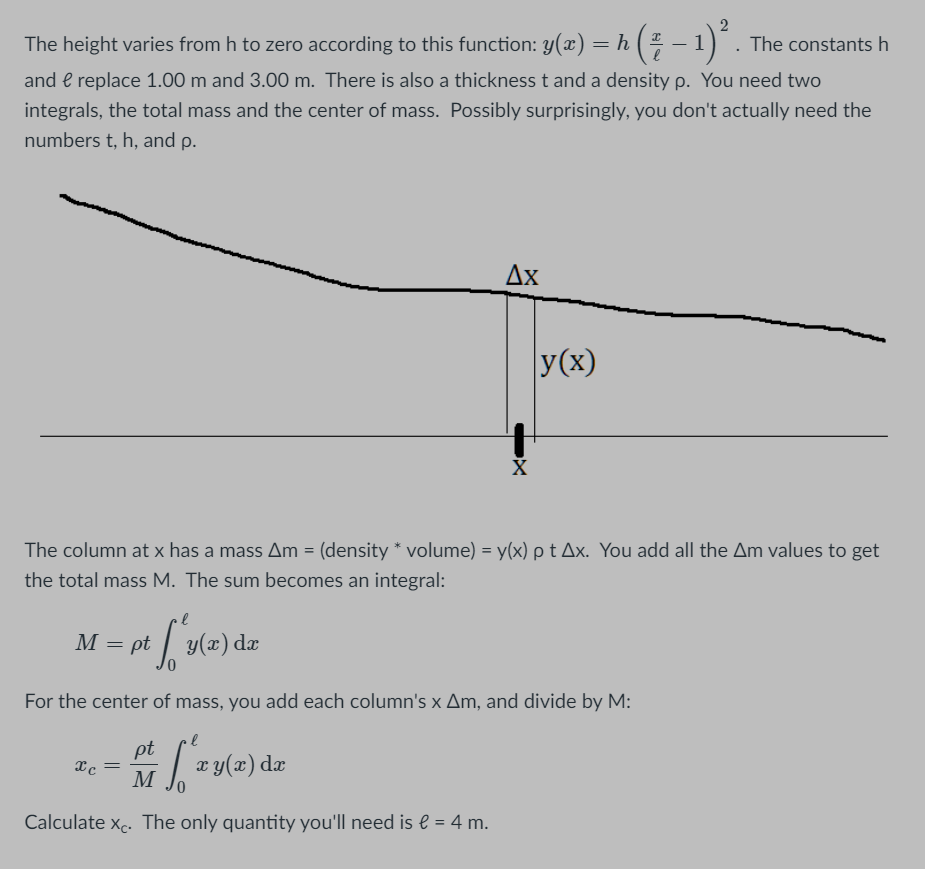The height varies from h to zero according to this function: y(x) = h ( -1). The constants h and e replace 1.00 m and 3.00 m. There is also a thicknesst and a density p. You need two integrals, the total mass and the center of mass. Possibly surprisingly, you don't actually need the numbers t, h, and p. Ax y(x) The column at x has a mass Am = (density * volume) = y(x) p t Ax. You add all the Am values to get the total mass M. The sum becomes an integral: М — pt y(x) dæ %3D For the center of mass, you add each column's x Am, and divide by M: pt xy(x) dæ ap (2)i z M Calculate xc. The only quantity you'll need is e = 4 m.
The height varies from h to zero according to this function: y(x) = h ( -1). The constants h and e replace 1.00 m and 3.00 m. There is also a thicknesst and a density p. You need two integrals, the total mass and the center of mass. Possibly surprisingly, you don't actually need the numbers t, h, and p. Ax y(x) The column at x has a mass Am = (density * volume) = y(x) p t Ax. You add all the Am values to get the total mass M. The sum becomes an integral: М — pt y(x) dæ %3D For the center of mass, you add each column's x Am, and divide by M: pt xy(x) dæ ap (2)i z M Calculate xc. The only quantity you'll need is e = 4 m.
University Physics Volume 1
18th Edition
ISBN:9781938168277
Author:William Moebs, Samuel J. Ling, Jeff Sanny
Publisher:William Moebs, Samuel J. Ling, Jeff Sanny
Chapter9: Linear Momentum And Collisions
Section: Chapter Questions
Problem 67P: Two particles of masses m1 and m2 move uniformly in different circles of radii R1 and R1 about the...
Related questions
Concept explainers
Rotational Equilibrium And Rotational Dynamics
In physics, the state of balance between the forces and the dynamics of motion is called the equilibrium state. The balance between various forces acting on a system in a rotational motion is called rotational equilibrium or rotational dynamics.
Equilibrium of Forces
The tension created on one body during push or pull is known as force.
Question

Transcribed Image Text:2
The height varies from h to zero according to this function: y(x) = h ( –- 1) . The constants h
and e replace 1.00 m and 3.00 m. There is also a thicknesst and a density p. You need two
integrals, the total mass and the center of mass. Possibly surprisingly, you don't actually need the
numbers t, h, and p.
Ax
y(x)
The column at x has a mass Am = (density * volume) = y(x) p t Ax. You add all the Am values to get
the total mass M. The sum becomes an integral:
M = pt | y(a) dz
For the center of mass, you add each column's x Am, and divide by M:
pt
a y(x) dæ
%3D
M
Calculate xc. The only quantity you'll need is e = 4 m.
Expert Solution
This question has been solved!
Explore an expertly crafted, step-by-step solution for a thorough understanding of key concepts.
Step by step
Solved in 3 steps

Knowledge Booster
Learn more about
Need a deep-dive on the concept behind this application? Look no further. Learn more about this topic, physics and related others by exploring similar questions and additional content below.Recommended textbooks for you

University Physics Volume 1
Physics
ISBN:
9781938168277
Author:
William Moebs, Samuel J. Ling, Jeff Sanny
Publisher:
OpenStax - Rice University

Physics for Scientists and Engineers: Foundations…
Physics
ISBN:
9781133939146
Author:
Katz, Debora M.
Publisher:
Cengage Learning

Principles of Physics: A Calculus-Based Text
Physics
ISBN:
9781133104261
Author:
Raymond A. Serway, John W. Jewett
Publisher:
Cengage Learning

University Physics Volume 1
Physics
ISBN:
9781938168277
Author:
William Moebs, Samuel J. Ling, Jeff Sanny
Publisher:
OpenStax - Rice University

Physics for Scientists and Engineers: Foundations…
Physics
ISBN:
9781133939146
Author:
Katz, Debora M.
Publisher:
Cengage Learning

Principles of Physics: A Calculus-Based Text
Physics
ISBN:
9781133104261
Author:
Raymond A. Serway, John W. Jewett
Publisher:
Cengage Learning

Physics for Scientists and Engineers with Modern …
Physics
ISBN:
9781337553292
Author:
Raymond A. Serway, John W. Jewett
Publisher:
Cengage Learning